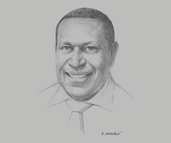Jerry Garry, Managing Director, Mineral Resources Authority (MRA): Interview

Interview: Jerry Garry
In what ways do global commodity markets affect the development of mining in Papua New Guinea?
JERRY GARRY: It is difficult to predict mineral prices, given global volatility and the many factors influencing price. Gold remains PNG’s key mineral, as it accounted for 72% of mineral revenue in 2017-18. It is also one of the most volatile commodities, and therefore exposes our economy to greater risk. The US-China trade dispute is an obvious external variable that is becoming more serious and complex. Its effects are probably most substantial for nickel, copper and cobalt prices, as China is our main source of demand for these resources.
Cobalt had a wonderful run on the back of the sudden expansion in the electric vehicle market to its $90,000 a tonne peak in 2017 but it has come back by two-thirds since, as manufacturers are seeking alternatives due to its high prices. We also expect China to continue to drive demand for copper and nickel. Another cause of the fluctuation is the appreciation of the US dollar in response to the recovering economy and rising interest rates, which have historically led to decreases in the price of gold. The focus for PNG will be on sustaining a consistent level of production and increasing it where possible. To this end, established mines will launch several new initiatives within coming years.
What progress is being made on mining projects?
GARRY: Wafi-Golpu and Frieda River remain under assessment in the regulatory approvals process. As of early September 2019 the federal and provincial governments were discussing Wafi-Golpu. Frieda is also back under assessment following the lodgement of new proposals for development based upon its altered development strategy for shared infrastructure supported by new feasibility studies. The relevant government agencies, including the MRA, are working with the state’s negotiating team to complete assessments for Wafi-Golpu as indicated and then for Frieda, more likely in 2020. While court injunctions obtained by a faction of landowners have potentially complicated the Wafi timeline, it appears that any lost time will largely be recovered now that national court consent orders have been negotiated through MRA’s initiatives. At the end of 2018 the mine operator Ramu NiCo lodged a formal variation application for a 100% upgrade and expansion of its mine, slurry pipeline and refinery, with capital expenditure of approximately $1.5bn over four years. If approved, this expansion will likely enter construction ahead of other major mining projects. However, Wafi-Golpu has also lodged a variation application to start development of the Nambonga decline to enable underground exploration for the benefit of further engineering feasibility. These works would have a total cost of between approximately PGK200m ($60.7m) and PGK300m ($90.9m), and have now been approved subject to conditions for immediate commencement.
How can the regulators lift sector competitiveness?
GARRY: New laws must find the right balance between wealth distribution and a competitive fiscal and regulatory regime. PNG is starting to realise that its mining sector no longer requires state concessions to attract quality investment. Jurisdictional studies undertaken in conjunction with the new legislation suggest that PNG could lift its fiscal position without reducing its competitiveness. The other key factor that investors consider when looking to invest is the stability and fairness of a regulatory regime. PNG has been stable for 50 years with a mature mining sector, and this will not be affected by the proposed laws. To the contrary, we anticipate the new legislation will enhance an already attractive regulatory regime. We have conducted a rough estimation of PNG’s mineral resources and concluded that current mines and new developments can support 50-100 years of extraction. The Lihir mine alone is the world’s third-largest known reserve, with 56m oz. Furthermore, MRA is utilising innovative exploration techniques to ensure the sustainability of the sector.
You have reached the limit of premium articles you can view for free.
Choose from the options below to purchase print or digital editions of our Reports. You can also purchase a website subscription giving you unlimited access to all of our Reports online for 12 months.
If you have already purchased this Report or have a website subscription, please login to continue.

